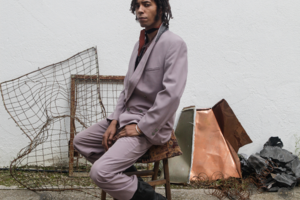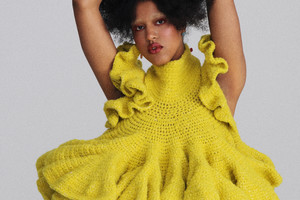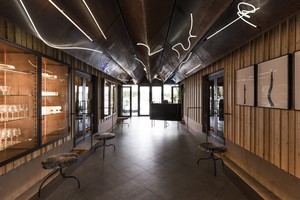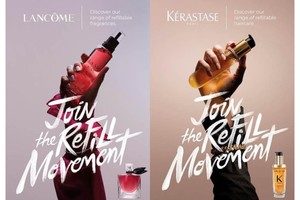An Interview with Lío Mehiel
Written by Josie McNeill by Josie McNeillWhen trans-masculine filmmaker, actor, and artist Lío Mehiel came across the toxic, man-made lake of the Salton Sea in Bombay Beach, California, they saw a metaphor for the experience of transgender people in the world.
“It felt like a warning message, that underneath this man-made, toxic lake, the world had drowned, and the world is drowning,” Mehiel said. “And like, the powers that be … are distracting us by getting us to argue about whether or not trans people should exist and whether women should have the choice to get an abortion. It's like we're being distracted by this shit when our world is drowning, and it's underneath the toxic lake of our own making.”
Mehiel explored this comparison and others in their photograph 'angels in a drowning world.' The piece, which was shot by trans masculine photographer Wynne Nielly, will be on display as part of the ‘Saints and Sinners’ exhibition in the Guts Gallery in London from June 9 to July 7. The exhibition showcases art by LGBTQIA+ artists and aims to explore what it means to be queer in a time where many safe spaces are being physically closed.
The trans experience is a topic Mehiel explores through their multitude of artistic pursuits, including their portrayal of Feña in the film 'Mutt,' which will be released August 18. Mehiel was awarded the U.S. Dramatic Special Jury Award for Acting at the Sundance Film Festival on Jan. 27 for their leading role in the film. 'Mutt' centers around a tumultuous, emotion-filled day for Feña, a young trans masculine person.
So with all of that, if you haven’t heard Mehiel’s name in conversations in the arts world yet, you probably will soon.
Can you start off by telling me a little bit about yourself and your background in the arts?
I'm a Puerto Rican and Greek trans masculine artist. I'm a filmmaker and I'm also an actor. I started out actually dancing salsa when I was seven years old, professionally, and then I was acting on Broadway in New York as a kid. And then it really wasn't until University and upon graduating that I started to form more in the installation and the visual art space, which really just serves as a passion space for me. It's not something I necessarily have an agenda about making money from or building a career because acting and filmmaking takes up the industrious side of my work. But visual art and installation is something I do as a way to explore and pilot out aspects of my identity. And to sort of reckon with the difficult things that I see in the world. Like I sort of process it through photo projects, in collaboration with other artists.
What drew you to photography? Was it mostly your filmmaking background?
I think that I'm an image maker and creating images has always been really fascinating to me, especially as a queer and trans artist because I spent so much time in my life before I transitioned thinking about the image of myself and trying to figure out how to both create an image that was what I thought would be acceptable to the outside world and also understand what it is that people were perceiving about me that was leading them to treat me in a certain way. And so I think Trans and Queer people, especially when they're making art, have a sort of—or at least I can only speak for myself—I have a relationship to image making that is deeply personal because of the way that it's threaded throughout my life.
How did you come up with the concept for the angels of a drowning world photoshoot?
So, a very close friend of mine is the one of the lead producers of this arts festival called the Bombay Beach Biennale. And it happens at Bombay Beach, which is a partially abandoned desert town about 45 minutes past Palm Springs and California. And it really feels like it's the end of the world. Like it's the last stop in the world that you would get to if the world was flat. And the town is sitting on a man made, toxic lake called the Salton Sea, which is a really rich and inspiring, jumping off point for a lot of artists.
[The Bombay arts festival was] able to give me a small grant to do some kind of installation and performance piece. At the time, I was already working on developing a collection of sculptures of trans and gender expansive folks, which is called Angels, with Holly Sylius, who made the sculpture of me that is in this photo. And then this opportunity came up and I was like, what are the implications of putting the sculpture of a trans person, me, and this you know, euphoric moment in my life commemorating my top surgery, inside of this man made toxic lake. I became obsessed with the metaphor within that and I'm still obsessed with it. I'm now sort of in a year-long project around this lake and the relationship to these sculptures. But yeah, I was just like, oh, this sea is an uncanny comparison to this project of developing these sculptures.
Did you say you're working on another project that surrounds the same concept? Is it an expansion of the photo or a different project altogether?
Next year in April for the festival, I'm hoping that we're going to be done with the 12 sculptures that we're building as part of the Angels collection. And once we're done, I want to install it in the sea in a semi circle position and do some kind of performance in relation to them. But it feels like a reference to the Last Supper. A lot of my work is for some reason organically in response to classical and religious themes. I think because the scale of that kind of art, even Renaissance period art, is the only scale that seems to match the crisis that we're in today. And I also think a part of it, why I'm sort of fixated on these themes and like 12, you know, that sort of holy religious number and recurring number, is because trans and gender expansive people have been left out of the archive of human history. And like they were there. Like we've existed as long as humans have existed. So I want to, as a love letter to my ancestors, insert them back into this religious and classical imagery as a way to honor them and also recreate a history that I wasn't able to receive as a young trans person.
What would you say is the central message of the photograph?
I think, I think the central message is that the apparent beauty of the image alongside the actual toxicity of the environment that I'm standing in, provide an apt metaphor for the mythos of America, that there is a parallel between the subjugated marginalized body stripped of its autonomy and the subjugated Earth, exploited for its natural resources. There's a parallel between those two things and that feels like the central message of what I'm trying to communicate.
This is being showcased alongside other works by LGBTQIA+ artists in the ‘Saints and Sinners’ exhibition in London. I was wondering if you could talk about what it means to you to be represented alongside these other artists?
Yeah, I mean, what they're doing with Guts Gallery is really inspiring. I had heard about them before I was invited to do the show and just the fact that they are so committed to changing the art industry in the art world from the inside out and building a community of artists where the artists are given, you know, ownership over their work in a radical way. So I feel so honored that my debut in London in the UK is with this gallery because it matches my values so deeply and then, you know, there are so many amazing up and coming artists that they've included in the show. But then they also have Catherine Opie, displaying some of her work. She's been an inspiration to me since I was a kid and could barely even understand what queerness was.
At the same time as the Guts show, a film that I'm a lead actor in called Mutt is premiering as part of Sundance London at Picturehouse. So I'm going to be able to come out for that film festival and at the same time, I'll be able to go to Guts Gallery and see the work in person which otherwise I wouldn't have been able to. So I'm really grateful.
I was gonna ask about your role in the movie. Why was it important for you to take this role as your character Feña?
Yeah, so this is my first time working as a lead actor in a feature film. It's written and directed by Vuk Lungulov-Klotz, who is also a mixed ethnicity trans guy just like me. And so the fact that my first role in a feature film was able to be a character that is so close to my experience and allows so much of me and my intersectional identity to shine through was such a blessing.
What was the most challenging part of acting in that role?
It was difficult to occupy the emotional state of feeling so defensive and alienated because Feña is a character who has gone through a lot of hardship in his life, and it has resulted in him having a pretty thick shell and being a bit more defensive and prickly and aggressive than I am as a person. I'm pretty soft and sensitive in my everyday life, and so being in that state of assuming that nobody understands you and people aren't really on your side and assuming that they don't love you for the, you know, four weeks we were shooting and the two weeks that we were in prep almost made me feel like that, even in the moments when I wasn't shooting. It kind of got me a little defensive or sad myself, you know, just occupying that emotional state for so long. It just kind of infiltrated my life, and that was challenging.
Is there anything you would like viewers to take away from your role in the movie?
Yeah, I mean, I think one of the most beautiful things that I've heard from audiences is that for folks who have never met a trans person, or who don't know any trans people, they feel like they walk away from the movie with a new friend who happens to be trans. People really love Feña, and it feels like such a gift to play a character that is accessible in that way. And so I hope that audiences walk away being like “here's just a day in the life of a trans person, and even if I've never thought that I'd have any relationship to this community, I do now because I see them and I understand them, and I get that they're just human beings too.”
You're also the first trans actor to win the Special Jury Prize for Best acting at the Sundance Film Festival. I just wanted you to speak on how you felt getting that accolade.
So that was crazy. I actually didn't know that there was an award. It was a Special Jury Prize, they don't give it out every year, so I wasn't even like, hoping that it would be a possibility. So the fact that, you know, there were big celebrities like Ben Platt and Jonathan Majors and like all these folks who are at the Oscars every year up for the award, but they gave it to me, felt like they were sort of saying to the industry, hey, we believe in this person enough that we want to give them this award, and recognize them in this way because we want them to have a real career. After having worked as an artist, you know, for so many years of my life, and really just doing it when nobody's watching and nobody notices and nobody cares. Then to finally be in a film that has a real platform and to be honored in that way was really crazy. And also to be the first trans person. I mean, when you're a trans artist, you are more likely to be one of the first at something than other people simply because there hasn't been as much access for trans folks. But I think for me, I want to have a platform so that I can spread love and share my experience. It feels like this award sort of helped me on the journey of being able to access people and change people's minds through the art that I make.
What do you think about the level of representation trans people have in the arts in today's world?
I think we're doing a lot better than we were doing a few years ago. But there's still a long way to go. What I've been thinking about is, as much as it is important to have trans folks in front of the camera, it's even more important to have trans folks behind the camera, specifically in the decision making world. I want to see more trans agents. I want to see more trans executives at production companies and studios. I want to see more trans managers and film financiers, because it's all of those folks who are really the ones who are deciding what movies get made and what platforms the movies are able to garner. So beyond just telling trans stories, which we definitely need to do, can we have the system that runs the storytelling mechanism include more trans people too?













